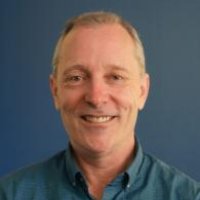At the end of part 1, Marie Story had just refused to answer her students’ questions about why the Colorado River turns blue when it meets the Little Colorado. Here is how she plans to use that observation, or “phenomenon,” to guide her students through a lesson.
Students would begin to scaffold their own experiences and observations into the discussion, asking more and more questions. We would park the question on the back whiteboard, and launch into student-designed investigations on refraction of light. Students would begin to build up a vocabulary that they could use to explain the phenomena listed above and they would begin to make connections across different activities. Students would draw motivation for building this vocabulary and doing the work because deep down, they wanted to know why that water is blue. They want to know because they want to know what to look for to find their own beautiful oasis.
In the end, we would revisit the question. Students would easily be able to explain why the water is blue without very much prompting from me. Often times, they would begin to make their own connections to similar phenomena in their own lives and share that with the class and me.
This small example of a connection stands out to me because I know I will be sharing it in class in the next few months in my 8th grade Physical Science classroom. However, I teach a lot of summer camps, after school science clubs, and coaching and teaching teachers, so I know that I will be using so many other experiences as the opportunities present themselves.
Courtesy of Nathan Chisholm
Story is very busy, in and out of the classroom. She teaches in afterschool programs and summer camps. She seeks out professional development like candy. Teaching is not a job for her; it is her way of life. You can tell that she is genuine in her commitment to her teaching, and in her curiosity and thirst for engagement. We at NCSE are pleased that we were able to offer her an enriching experience, but we recognize that the best experience teachers can have is with peers. We want to expand the opportunities we can provide for teachers to interact with each other, and we are hoping that Story will be one of our Teacher Ambassadors. We’re just getting started planning these expansions for NCSEteach, but I’d like to leave you with one last excerpt from her essay.
Courtesy of Nathan Chisholm
I cannot wait to talk about the fossils and the Great Unconformity, but more than what we saw in the Canyon, I cannot wait to share what I have learned from the other participants in the program. From the the membranes of cells, astronomy resources from Canada, immune disorders, California Condors, fluorescent rocks, the benefits of driving a Tesla, and the chemical reactions required to make homemade ice cream, there wasn’t a day that I wasn’t learning things and making those connections for my classroom with the other guests. As a teacher, perhaps the most impressive part of the entire trip was to be so welcomed and appreciated by such a talented and brilliant group of scientists both on the trip and by those who supported us at home.
While I was in the Canyon, I took a lot of time to talk to the brilliant people on my trip and to learn from them. When I wasn’t visiting, I was writing down stories, ideas and other phenomena that I can share with my students. This fall, when I go back to school, I am excited to not only be armed with the mold of my mouth, but also with a journal of phenomena that I can use to make science a bit more engaging.
Courtesy of Nathan Chisholm

